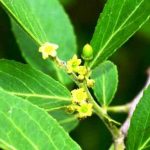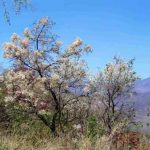TREE LIFE
October 1984
FORTHCOMING CALENDAR
Tuesday October 2nd : Botanic Garden Walk. Meet in the Car Park at 1645 for 1700 hours.
Sunday, October 21st : Kyle Farm, Muriel Mine, Banket. This month we are very pleased to be joining the Ayshire Branch outing to Kyle Farm, Banket, the home of Tree Society members Ted and Ann Hatley. This is on the edge of the Great Dyke, so we will be seeing an interesting combination of vegetation types. We will take the main road to Banket going there and will probably return to Harare crossing the Dyke at Cedar Pass to make an interesting change. Gill Henderson and Benedicta Groves will have done a recce so I am confident that we will have a splendid outing. A bus has been booked and will leave Monomatapa Car Park at 0815 hours. Fare $10.
MATABELELAND CALENDAR
Sunday October 7th : To Hillside Dams, meet at 0830 in the Car Park below the Aloes.
CHEGUTU CALENDAR
Sunday 7th October : The Chegutu nuts will be meeting at Stockdale Estate where Richard Etheredge is kindly allowing us to see his precious stretch of riverine bush. Richard is a very keen wild life conservationist and it is a privilege indeed to be allowed to see this well protected area of bush, he has armed guards patrolling to prevent wood cutting and poaching, and especially to protect the bush buck that live there.
BOTANIC GARDEN WALK TUESDAY 4TH SEPTEMBER 1984
Once again we are indebted to Tom Muller for a rewarding walk around the Botanic Gardens, this time looking at the citrus family, the RUTACEAE. Just to place the family in a broader context, according to Cronquist, 1981, it belongs in the largest of the six sub-classes of the dicotyledons, the Rosales are the central order of this subclass. From the Rosales there is one off shoot consisting of three generally compound leaved orders; the Sapindales, Geraniales and Apiales. The Spindales are usually woody plants and include the MELIANTHACEAE, e.g. Bersama, SAPINDACEAE, e.g. Zanha, BURSERACEAE e.g. Commiphora, ANACARDIACEAE e.g. Lannea, SMAROUBACEAE e.g. Kirkia, MELIACEAE, e.g. Khaya and the RUTACEAE. The Geraniales have been considered as a herbaceous off shoot of the Sapindales and include Oxalis, Geranium, the nasturtium and Impatiens. The Apiales are a softly woody or herbaceous order also derived from the Sapindales, and include the ARALIACEAE e.g. Cussonia and APIACEAE e.g. Steganotaenia. Working with leaf characters as we do, it helps to see these families together, visualizing their compound leaves and trying to see the differences between this unity and other families with compound leaves, such as the BIGNONIACEAE e.g. Kigelia, the legume complex, e.g. Acacia and Brachystegia, and the OLEACEAE e.g. Schrebera.
With this overview we immediately see that a lemon tree with a simple leaf is not a typical RUTACEAE. The leaves of almost all RUTACEAE do have tiny gland dots which can be seen when held up to the light. These glands give the leaf a distinctly aromatic smell when crushed. This smell is incorporated into Sack, which was once the favourite of English drinks. Sack is a mead, or honey wine, favoured with the RUTACEAE herb rue. Generally RUTACEAE leaves are alternate and lack stipules.
Four of the nine indigenous tree or shrub genera have trifoliate leaves, Vepris, Teclea, Oricia and Toddaliopsis. The genera are difficult to tell apart on leaf features alone. We began the walk by looking at the rare Vepris zambesiaca. This specimen had been collected by the late John Orpen as a seedling from a patch of mopane woodland on the Beatrice Road. We noted the gland dots and aromatic smell. Notable features of this species were its winged petiole, soft velvety feel to the leaf and a finely serrate or scalloped margin. The other local Vepris, V. reflexa has an entire, leathery blade and lacks the winged petiole. It grows in woodland of the lowveld valleys. None of these four trifoliate tree and shrub genera has thorns or spines, although later in the walk we saw the scrambling Toddalia asiatica with trifoliate leaves and vicious thorns along the stem, the petiole as well as the main leaf veins. This aggressive forest climber has fruits which resemble small naartjies. During the war it was suggested that this climber be planted around dwellings in high rainfall areas as a protection instead of the exotic Mauritious Thorn.
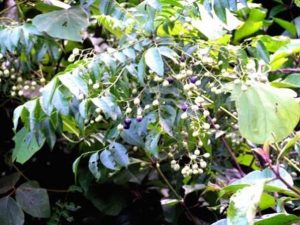
Clausena anisata. Photo: Jos Stevens. Source: Flora of Zimbabwe
Wandering into the forest section we were accosted by the smell of Clausena anisata before we saw the trees themselves. The smell varies in individual trees, from a pleasant aniseed smell to that described by the Afrikaans common name as perdepis, horse urine. Also unarmed, this is a RUTACEAE with the pinnate leaflets arranged alternately on the rachis. Clausena is common along river valleys of the eastern highlands. Tom’s specimens have seeded well, the seedlings forming a lush green ground cover beneath the adults.
On the edge of the forest we noted the large leaves of Zanthoxylum gilletii, ex Fagara macrophylla. This species grows into a large under storey tree to 30 m in Mt. Selinda. The cat’s claws on the bark may develop into corky bosses up to 5 cm in length. All Zanthoxylum species have alternate, compound, imparipinnate leaves. The leaflets of Z. gilletii are markedly asymmetrical with the margins rolled under, and with spines on the rachis. On the path leading to the Ficus bubu we found Z. trijugum with similar thorns to Z. gilletii but with smaller leaflets. This tree grows in specialized environments with the lowveld valleys. Although the RUTACEAE generally appear to be evergreen, a few of these trees had lost all their leaves.
Alongside the Z. trijugum stood Teclea trichocarpa. This is vegetatively similar to Vepris but they differ as to floral structure. Like Vepris, Teclea is unarmed with alternate, trifoliate and gland dotted leaves. T. trichocarpa grows in the relatively dry rain forests of the Nyoni mountains. The leaves are smooth with an entire margin.
Out on the lawns Tom showed us a number of Citropsis daweana with the markedly winged rachis on their slightly furry pinnate leaf. This is one of the members of the jesse bush, or layered dry forest, as Tom prefers to call it, of the Zambezi lowveld, and has long spines.
We wandered past the Dovyalis hispidula which we ate of so freely a few months back, but which is now dry and lifeless, whereupon Tom found a short, thin stick in the ground. Entirely leafless but with green buds on the few branches, and no distinctive features what so ever. While we carefully tried to avoid stampeding this notable nothing, Tom assured us that this was Zanthoxyum leprieurii which apparently has narrow leaflets. This slow growing, and not even knee high, specimen was collected in the Hartley area near the Umfuli River and was planted in 1974.
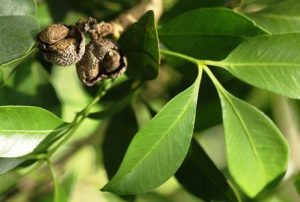
Toddaliopsis bremekampii. Photo: Bart Wursten. Source: Flora of Zimbabwe
A brisk stride to the S.E. Lowveld section led us to Toddaliopsis bremekampii, yet another trifoliate RUTACEAE without spines. The shiny leaf has a long petiole. Toddaliopsis can be found above Chipinda Pools and on the low hills of the S.E Lowveld which receive some guti. Despite the dry climate in these areas this tree is evergreen, although after three years of drought we were unable to detect the RUTACEAE smell but we did see the gland dots against the setting sun.
Doing families keeps us fit as we crossed the lawns once again, past the Raphia palms to see two very similar RUTACEAE, Teclea nobilis and Oricia bachmonnii. Both have large trifoliate leaves with a shiny surface. On the Oricia, opposite leaves may be found, whereas the Teclea usually has alternate leaves. Oricia grows in the dryer area of the wet Mt. Selinda forest, whereas T. nobilis is a drier forest pioneer. Both trees occur together in the Vumba.
Before the light finally faded we were able to have a look at an interesting exception within the family, the Cape Chestnut, Calodendrum capense. Not only does this have a simple leaf, but the leaves are also opposite, an unusual combination within the RUTACEAE. We may remember the large specimen across the lawns at Trevor Gordon’s house which was in full flower for our last outing. These large lily like flowers are pink in colour. Bob Drummond shook down a number of the dried fruit capsules which resemble chestnuts. These capsules split into a number of segments. Dick Petheram explained that these dried fruits were a handy feature to remember as the capsules often stick out above the tree and can be detected through binoculars. These trees are something like the Craibia of the Vumba; when in flower the large colourful trees stand out distinctly against the green forest on the mountain slopes, but once within the forest they are difficult to find unless one is directly below them. Calodendrum capense grows in the high to medium altitude dry rainfall forest together with Dais, Teclea and Curtisia. As garden subjects they often suffer from many of the Citrus diseases.
By this time we were straining our eyes to see the gland dotted leaves so we called it a day. We must thank Tom once again for an informative walk.
-Kim ST.J.Damstra
BARNHILL ESTATE, MARONDERA 16TH SEPTEMBER 1984
This month saw us at Barnhill Estate, the home of Ian and Jill Hunter, in the Marondera/Ruzawi area. We had a very pleasant drive out there and were able to pick up our Marondera members and see many of the trees which are spectacular at this time of year. A lot of the msasas were still wearing their spring colours and Dombeya rotundifolia, covered in white flowers, and Cassia singueana in yellow, were seen all along the road, the Dombeya predominating.
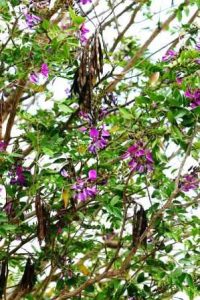
Mundulea sericea. Photo: Bart Wursten. Source: Flora of Zimbabwe
On arriving at Barnhill Estate, Jill Hunter led the way to a dwala where Meg had promised us that we would see some interesting trees, we were not disappointed. One of the first trees we saw was Mundulea sericea which had a few mauve flowers. It looks a bit like Bolusanthus speciosus but Bolusanthus has sickle shaped leaves whereas Mundulea has not. It was growing on rock but it must have had a good water supply underneath.
Moving off the rock we saw Rhus tenuinervis with its trifoliolate, velvety leaves which give the characteristic resinous smell of Rhus when crushed and Combretum molle with its smallish fruits. The Combretum had dropped all its furry leaves but they were still on the ground underneath the tree.
We then walked onto the dwala which had resurrection plant growing on it and moved at a smart pace, for the Tree Society, to more promising ground. We did not however, ignore the trees that we passed on the way. Amongst them, Pterocarpus angolensis in fruit, Combretum molle and C. zeyheri growing right next to each other and giving a very good demonstration of the size differences between the fruit, Peltophorum africanum with seed pods, Parinari curatellifolia and Albizia antunesiana covered in buds a few of which had already opened, a sight we do not often see on our trips, as well as two buck and a hare!
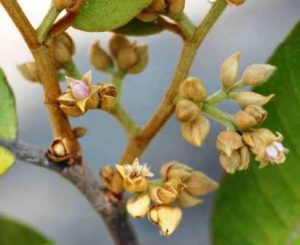
Parinari curatellifolia flowers. Photo: Bart Wursten. Source: Flora of Zimbabwe
When we came off the dwala we saw Burkea africana. Like many trees at this time of year it had no leaves and was just about to come into flower, a ploy to tax our brains no doubt. The buds formed green spikes but the tree still showed the clue we always look for, the rusty red velvety tips of the branches.
Next came the highlight of the day, a grove of Ochna pulchra in flower. This is a rare sight as the greenish/yellow flowers only last a day or so, and then the petals drop leaving the persistent sepals which later turn shell pink and may deepen to red as the fruits develop. The bark peels off the stem and younger branches to reveal the smooth underbark, while at the base of the trunk the bark is rough. Paul Coates Palgrave used to call it the mermaid tree because it is smooth at the top and scaly below!
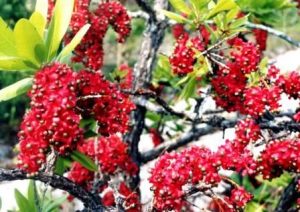
Ochna pulchra. Photo: Bart Wursten. Source: Flora of Zimbabwe
It seemed to be a day of Combretum as the next tree we looked at was Combretum apiculatum recognizable by the slight twist at the ends of the leaves, followed by C. erythrophyllum which was just coming into flower. Its flowers are different to the other members of the genus because they are more or less round as opposed to spikes. Another means of recognizing this species is the pits along the trunk and branches which look rather like large claw marks. It is usually found along river banks and in fact the river was not far off although we could not see it. Also being situated at the bottom of the dwala it would have a fairly good water supply.
Immediately underneath the Combretum was a very small specimen of Cassine transvaalensis which we have not seen for quite a while. It is easy to tell it apart from the rest of the genus by its narrow spiny leaves.
Moving on there was a typical specimen of Combretum collinum showing all the characters that we should look for, a very white and scaly under side to the leaves and reddish brown fruits which are too small to be those of C. zeyheri and too big to be anything else.
On the ground we saw the dwarf Lannea, Lannea edulis in flower. It will later have edible berries. We also saw Faurea saligna, Carissa edulis and Cassia singueana.
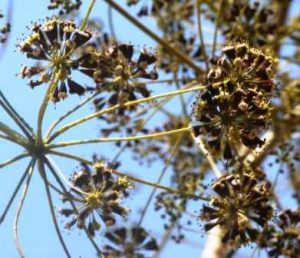
Steganotaenia araliacea. Photo: Bart Wursten. Source: Flora of Zimbabwe
By this time we were moving back towards the bus, still along the bottom of the dwala. There were two specimens of Strychnos cocculoides, one showing its lovely corky bark and the other covered in the characteristically white spotted fruits.
Not far from them we were astounded to see an enormous specimen of Protea gaguedi. Not being very good at estimating heights, I will not hazard a guess as to how tall it was but it was certainly very tall and it was interesting to note that the specimens of Faurea saligna, also in the PROTEACEAE family, which we had seen throughout the morning, were large as well.
Wandering on we saw Steganotaenia araliacea which belongs to the carrot family, UMBELLIFERAE. There were numerous small trees clearly showing the umbels as they were all in seed. The common name for this the pop gun tree as, apparently, children make pop guns by slipping the bark off a length of stem.
We also saw Ficus thonningii. There was a bit of a debate as to what it was but it was eventually decided that it was F. thonningii as F. verruculosa has blotched fruit and the fruit of our specimen did not have blotches. Another fig growing there was F. sur, which has large leaves which are wavy on the edges and have heavy veins underneath. The new leaves have a reddish-brown colour.
The last tree we looked at before getting back on the bus was Tarchonanthus camphoratus, COMPOSITAE family, last seen at Wolle Kirk’s farm.
After lunch in the lovely garden we went to the river below the dam. We walked across the bridge and wandered down the river where we saw amongst others, Pappea capensis, Dovyalis zeyheri, Osyris lanceolata and Salix subserrata. S. subserrata has pink petioles and alternate leaves. Myrica and Rhus also have pink petioles but they both have opposite leaves. We had not got very far before we saw that there were not many more trees along the river so we climbed through the fence where things looked more promising. Like last month at Bushman’s Point, a lot of the trees did not have any leaves but we saw Maytenus heterophylla with sharp spines and Ziziphus mucronata with no leaves but recognizable by its typical thorn arrangement of one pointing forward and one back.
On the termite mound, we saw a large Schotia brachypetala. It has paripinnate leaves and the leaflets have a rounded, asymmetric base. There was an old branch with pods on it which are very characteristic, the strings on either side staying on the tree long after the rest of the pod has fallen away, rather like Elephantorrhiza goetzei but the pods are smaller.
Later we saw another Schotia brachypetala, this one was in full flower. The flowers are red but it is the sepals not the petals which are this colour, the petals are either absent or very reduced. There were also some pods on the tree and we were able to see a seed half covered with a bright yellow aril. After that magnificent sight we returned to the bus. Our thanks to Ian and Jill Hunter for letting us have the opportunity of seeing some of the wonderful trees on Barnhill Estate.
On the return journey we stopped in Marondera to examine a traveler’s tree in a garden alongside the road. Both Gill Masterson and Dick Petheram phoned to confirm the tree as Ravenala madagascariensis which now belongs to the STRELITZIACEAE. It is the only member of this genus and bears a large fan of leaves which are borne in a flat plane. This striking plant gets its common name because water accumulated in the leaf bases and has been used for drinking in cases of necessity. It may be found by piercing the base with a knife. Tom Muller tells of a large specimen he had alongside the herbarium which died during a cold winter. Apparently, these trees are fairly common garden subjects in Natal as well as in the South east Lowveld.
-Barbara Browning
MATABELELAND NOTES
On Sunday 2nd September we went to the Kalahari Sand Area of Good Hope Farm, beyond Aisleby. It was very dry but there was more leaf than expected, which encouraged our detective work, a useful exercise in knowing what to expect.
We saw Acacia chariessa and A. fleckii, Baikiaea plurijuga, Bauhinia micrantha, Combretum collinum and C. zeyheri, Canthium lividum, Grewia retinervis, Ochna pulchra and Ochna schweinfurthiana, Strychnos cocculoides, Terminalia brachystemma and so on.
Afterwards we went to see the Olive Wood Olea europaea workshop of Mr. Bob Aveley at Aisleby, and admired his fine workmanship, and his fine stack of Olive Wood, all dead trees and hard to come by nowadays. We also had a quick look at the Sewage Works, and the nearly empty dam
We were all most fascinated by your Acacia chariessa which we eventually tracked down in Davidson and Jeppe, 1981. Acacia, as “a graceful feathery shrub up to 3 m high, occasionally forming thickets, endemic to western, central and southern Zimbabwe, abundant around Bulawayo”. A new plant to some of us up here – maybe you could tell us more.
-C. Sykes
CHEGUTU NOTES
During September a small group of us met at Mkarati Farm, Gazema, where our hosts were Mr. and Mrs. Graham Speight (daughter and son in law of the Archers, keen enthusiasts of the Bulawayo Branch).
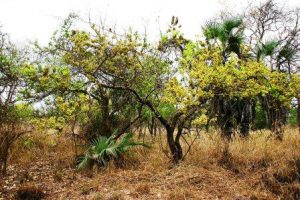
Combretum fragrans. Photo: Bart Wursten. Source: Flora of Zimbabwe
Our day started well with the sight of a fine Pericopsis angolensis, the Muwanga, which many people have noticed along the main Karoi Chirundu road. We drove through old lands and to our great delight came upon two small Stereospermum kunthianum in full bloom, hopefully Graham will be able to collect us some seed next year. It was a long drive through the ranch called Ezintebeni, and most of the trees were leafless, but the Lannea discolor were blooming, Combretum fragrans were proving the aptness of the name, and the gleam of the Cassia abbreviata was especially welcome. The ranch certainly was hilly, it would have been impossible to explore it all, so we had to guess that here and there were Commiphoras, the Sterculia africana were striking and unmistakable, as were the Brachystegia glaucescens and the distant and very ingens Euphorbia. It was a hot day and so the sight of huge shady trees on a sand bank at the Umfuli was a relief. We had our lunch under a very large Trichilia emetica. Further along the bank were large Mimusops zeyheri, a Kigelia africana in full fresh leaf and in bloom. Olive Reach noted that the Kigelia flowers come out in threes on the stem. There were two trees which we had to get help from Bob Drummond in order to identify, Ekebergia capensis and the tassel berry, Antidesma venosum. Luckily an almost leafless Afzelia quanzensis had one pod on it, although the bark alone should have told us. And then it was the long drive back, with plenty of Colophospermum mopane for those of us who live it – once the rains come the road to the river will be impossible. We all felt that it was baobab country, but the Speight father and son, who have been on the farms a long time, say they have never seen any.
It was a most interesting outing; the only pity of it is that the road through the ranch is only suitable for farm trucks.
-Ann Bianchi
ROOT NOTES : Wood anatomy is an interesting subject which I do not know a vast amount on, but the general idea is that Conifers have softwood, whereas dicotyledons have a hardwood. The reason for this is that the conifers rely entirely on small cells called tracheids for the movement of water from the roots to the leaves. Flowering plants have tracheids but they also possess xylem vessels as well. These vessels are wider cells open at both ends which connect in a vertical series to form continuous tubes up the stem. With this effective transport system other cells within the dicot trunk for a specialized strengthening cells and fibres. As a result, the wood is often stronger and denser and is known as Hardwood. In contrast, the softwood of conifers with mainly tracheids, have a homogeneous structure which is easily workable and is also suitable for papermaking.
A few very primitive dicot trees may have simple wood without vessels as well as their simple flower structure. If tracheids are less efficient conductors than vessels and cannot deliver the same rate of flow, what difference does this make to the distribution of conifers as opposed to dicot trees? One reference I found explained that in general the conifers overcome their poor transport system by controlling their evaporative water loss or transpiration. As a result they tend to be xerophytic with specialized leaves and are generally more successful in marginal environments. Here the tracheids are less of a disadvantage. Thus nature conifers dominate the boreal forest and grow on the dry mountain tops of Nyanga, Widdringtonia and Juniperus. This was all very well but how to the yellow woods, Podocarpus, fit into this explanation? One suggestion came from Sue, ex Milton, sorry Sue, I can’t find your latest generic name, and possibly in the abundance of water such as in the high rainfall forests this difference in wood anatomy is less important as trees compete for nutrients and light. Here the yellowwoods thrive well. One wonders whether the poor wood anatomy is responsible for the preferential demise of the conifers in the present drought. Vast numbers of exotic cypress and pines have died in and around Harare in the past year. If anyone has any further comments on this topic they would be most welcome.
-Kim ST.J.Damstra
ROOT NOTE Peggy Izzett sent us an interesting cutting from the S.A. Digest. Apparently Prof Eugene Dowdle, Head of the Department of Clinical Science and Immunology at the University of Cape is looking for as many Erythrina seeds as people are prepared to send him. A substance discovered within the seeds is thought to reduce thrombosis attacks and can help to simplify the production of a possible solvent for blood clots.
Any seeds may be sent to Prof Dowdle’s department UCT, Rondebosch, Cape Town.
“Prof Dowdle began looking for different and easier methods than those then being used to produce tissue plasminogen activator, in 1982. This material is an experimental blood clot dissolving drug.
While discussing his work with scientists Dr. Dawie Botes and R. Francois Joubert, at the GSIR’s National Chemic Research Laboratory, he learned of certain research they had done on an extract of coral tree seeds.
After further tests, Prof Dowdle found that an inhibitor discovered in the seed by Dr. Joubert, isolates and purifies the plasminogen activator in a simple manner.
The method now developed for preparing the plasminogen activator takes advantage of the fact that the seeds of the coral tree contain a protein that preferentially inhabits the activator, in this way allowing for its separation and purification.
The researchers now need a large quantity of this protein to produce the tissue plasminogen activator experimentally.
Letter to the Editor :
On a recent walk up Chingahali Mountain, next to Kamativi, I came across a fine specimen of what I think is a wild yellow wood. The trunk was 6-8 m high and very straight.
I got very excited when I saw it because it’s something I never expected to come across in this part of the world. If you, or any member of your society, is interested, I am willing to show it to you, though, let me assure you, it’s a fair climb to get there.
We can put a few people up for the night if you come over the weekend.
-Ray Perry, Kamativi Tin Mine, P.O. Kamativi.
Meditative Comment Section :
Extract from introductory “Content” page of “Thonner’s Analyticaly to the Families of Flowering Plants” Vol. 5 of the Leiden Botanical Series : Leiden University Press, 1981.
“All plants are hybrids, but some are greater bastards than others”.
R.W. Petheram
ROOT NOTES : Last month in the write-up on the MORACEAE I noted that the mulberry has separate sexes on the same tree. Since then the mulberries have come into bloom in Harare and despite repeated hunting on numerous trees we were unable to discover any male flowers at all. Cheryl Haxen eventually solved the problem by finding an all male tree which had probably grown from seed. The spikes of flowers looked like half ripe mulberries but instead of the stigmas which crown the female lowers, the male bears anthers. After the pollen has been released the male flowers all withered up.
-Kim ST.J.Damstra
PHILIP HAXEN CHAIRMAN


